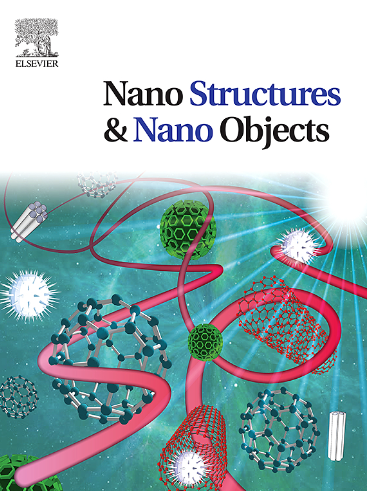Green synthesis by carambola fruit juice coprecipitation route, effect of nickel doping, and optical properties of spherical copper oxide nanoparticles
IF 5.45
Q1 Physics and Astronomy
引用次数: 0
Abstract
Doping CuO with Ni2 + has been preferred because of the closeness of the ionic radii of Cu2+ (0.72 Å) and Ni2+ (0.69 Å) but the trends in crystallite sizes as a consequence of Ni2+_ doping has been contradicted. Therefore, an independent study on the effect of doping CuO with Ni2+ was necessary. In this study, spherical nanostructured pure and nickel-doped cupric oxide (CuO) are synthesised by co-precipitation using Carambola fruit juice. The single molecular precursors are decomposed at a predetermined decomposition temperature of 350°C for 3 h. The Nickel doping concentrations used are 2.0 %, 4.0 %, 6.0 %, and 10.0 %. The single molecular precursors obtained were characterised by IR and TGA, while the decomposed samples were characterised by IR, SEM/EDS, PXRD, and UV–vis. The IR results revealed that the single molecular precursors were metal oxalates, whereas the decomposed samples were metal oxides (CuO and Ni-doped CuO). The SEM results show discrete spherical nanoparticles with a predominant spherical shape but with the porous morphology and particle size varying as Ni2+ are introduced in the CuO matrix. The EDS results indicate the presence of Cu and the progressive incorporation of Ni2+ ions in the CuO matrix., suggesting that the decomposed samples were CuO and Ni-doped CuO. X-ray diffraction (XRD) shows the formation of pure polycrystalline CuO with tenorite phases, which belong to the monoclinic structure. Two competing predominant adsorption peaks were observed corresponding to the (111) and (11͞1) crystal planes. Furthermore, the determination of crystal sizes from XRD data showed that the particle sizes ranged between 9 nm and 24 nm and, were greatly modified by the doping and dopant concentrations of Ni2+. The optical band gap of the decomposed samples fluctuated between 2.84 and 3.01 eV as the precursor concentration of nickel ions increased from 0.00 % to 10.0 %. Other unit cell parameters were calculated using particle size absorbance/transmittance data extracted from PXRD, and the results demonstrated an irregular trend. These results attribute the contradiction reported in literature to redistribution of particle sizes of the crystallites which correlate positively to the prevalent diffraction Braggs angles. Furthermore, the fundamental understanding of the effect of Ni2+ doping and increase in dopant concentration in the CuO matrix is governed by many factors including the size of the dopant ion, concentration of the dopant ions in the host matrix and morphology of the crystallites. These factors are all closely linked to the method of synthesis or crystallite growth.
杨桃汁共沉淀绿色合成路线、镍掺杂的影响及球形氧化铜纳米颗粒的光学性质
由于Cu2+ (0.72 Å)和Ni2+ (0.69 Å)的离子半径接近,CuO与Ni2 +的掺杂是首选的,但由于Ni2+_掺杂导致的晶体尺寸的变化趋势是矛盾的。因此,有必要对Ni2+掺杂CuO的影响进行独立研究。本研究以杨桃汁为原料,采用共沉淀法合成了球形纳米结构纯镍氧化铜(CuO)。单分子前驱体在350℃的预定分解温度下分解3 h。镍掺杂浓度分别为2.0 %、4.0 %、6.0 %和10.0 %。所得的单分子前驱体通过IR和TGA进行了表征,分解后的样品通过IR、SEM/EDS、PXRD和UV-vis进行了表征。红外光谱结果表明,单分子前驱体为金属草酸盐,而分解后的样品为金属氧化物(CuO和ni掺杂CuO)。SEM结果表明,纳米颗粒以球形为主,随着Ni2+的加入,纳米颗粒的孔隙形态和粒径发生变化。EDS结果表明Cu的存在和Ni2+离子在CuO基体中的逐渐掺入。,说明分解样品为CuO和ni掺杂CuO。x射线衍射(XRD)结果表明,制备的CuO为纯多晶,呈单斜晶结构,并带有tenorite相。两个相互竞争的主要吸附峰对应于(111)和(11)晶面。此外,通过XRD数据对晶体尺寸的测定表明,纳米tio2的晶粒尺寸在9 nm ~ 24 nm之间,Ni2+的掺杂和掺杂浓度对纳米tio2的晶粒尺寸有很大的影响。随着镍离子前驱体浓度从0.00 %增加到10.0 %,分解样品的光学带隙在2.84 ~ 3.01 eV之间波动。利用PXRD提取的颗粒尺寸吸光度/透射率数据计算了其他晶胞参数,结果显示出不规则的趋势。这些结果将文献报道的矛盾归因于晶体粒度的重新分布,这与普遍的衍射布拉格角呈正相关。此外,对Ni2+掺杂的影响和CuO基体中掺杂离子浓度的增加的基本认识是由许多因素决定的,包括掺杂离子的大小、基体中掺杂离子的浓度和晶体的形态。这些因素都与合成方法或晶体生长密切相关。
本文章由计算机程序翻译,如有差异,请以英文原文为准。
求助全文
约1分钟内获得全文
求助全文
来源期刊

Nano-Structures & Nano-Objects
Physics and Astronomy-Condensed Matter Physics
CiteScore
9.20
自引率
0.00%
发文量
60
审稿时长
22 days
期刊介绍:
Nano-Structures & Nano-Objects is a new journal devoted to all aspects of the synthesis and the properties of this new flourishing domain. The journal is devoted to novel architectures at the nano-level with an emphasis on new synthesis and characterization methods. The journal is focused on the objects rather than on their applications. However, the research for new applications of original nano-structures & nano-objects in various fields such as nano-electronics, energy conversion, catalysis, drug delivery and nano-medicine is also welcome. The scope of Nano-Structures & Nano-Objects involves: -Metal and alloy nanoparticles with complex nanostructures such as shape control, core-shell and dumbells -Oxide nanoparticles and nanostructures, with complex oxide/metal, oxide/surface and oxide /organic interfaces -Inorganic semi-conducting nanoparticles (quantum dots) with an emphasis on new phases, structures, shapes and complexity -Nanostructures involving molecular inorganic species such as nanoparticles of coordination compounds, molecular magnets, spin transition nanoparticles etc. or organic nano-objects, in particular for molecular electronics -Nanostructured materials such as nano-MOFs and nano-zeolites -Hetero-junctions between molecules and nano-objects, between different nano-objects & nanostructures or between nano-objects & nanostructures and surfaces -Methods of characterization specific of the nano size or adapted for the nano size such as X-ray and neutron scattering, light scattering, NMR, Raman, Plasmonics, near field microscopies, various TEM and SEM techniques, magnetic studies, etc .
 求助内容:
求助内容: 应助结果提醒方式:
应助结果提醒方式:


